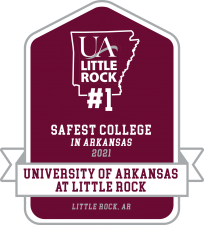A hazardous materials incident may be a spill or release of chemicals, radioactive materials or biological materials inside a building or to the environment. A qualified user may manage simple spills.
Major spills or emergencies require emergency assistance from the Little Rock Fire Department.
Simple spills should be cleaned up by the person causing the spill. Simple spills are those that do not spread quickly and do not endanger people, or the environment.
Major Spills or Emergencies
- Major spills or emergencies spread quickly and endanger people, property or the environment.
- DO NOT take any action to cleanup or handle the incident unless the material is in your laboratory/work area, you have received appropriate training for the material(s) involved, and personal protection equipment is available.
- Contact the UA Little Rock Police Department at 501-916-3400 and/or dial 911 and if possible, provide the dispatcher with the following information:
- Exact location of incident and its surroundings (i.e., close to storm drain).
- Name of material spilled and amount
- Any injuries
- Any noticeable release into the environment
- A safe location where you can meet with emergency crews
- Evacuate, assemble at a safe distance
- Account for individuals
- Wait for and provide information to responders
Biological Hazards
Biological agents may be delivered in the mail, packages, or as a wet or dry agent and the effects may not manifest themselves for some time. The following information concerns suspected biological agents.
- Immediately shut down all HVAC systems for the building. Isolate the suspected source of contamination.
- All potentially exposed persons should remain in the building and wait for emergency responders to arrive. Do not allow others into the area.
- Follow instructions of emergency responders and health officials.
Chemical Agent
Release of a chemical agent into the environment may be accidental or intentional. Look for the following indicators of a chemical release:
- Are there unconscious victims with minimal or no trauma?
- Are there multiple victims?
- Are victims experiencing nausea, trouble breathing, nausea, convulsions, blistering or discoloration of the skin?
- Are there dead animals present?
- Are there any unusual odors, smoke or vapor clouds present?
Immediate Actions
- Move away from the probable source of the contamination and help others move away.
- Stay away from any spilled substance and avoid touching it.
- Avoid touching victims until the substance has been identified.
- Try to stay upstream, uphill, and upwind of the release site.
- Follow the instructions of the emergency responders and health officials.
Radiation
Typically, exposure to radioactivity has no immediate symptoms. Heavy exposure to intense sources can cause radiation sickness. Three key factors that influence an individual’s radiation dose from exposure to a given source are as follows:
- Time – Reducing exposure time reduces the radiation dose
- Distance – When working distance from a radiation source is increased by a factor of two, the dose will be reduced by a factor of four.
- Shielding – Shielding is the use of any material to reduce the intensity of the radiation by absorption or reflection.
Notifications and Reporting
- If the incident involves any radioactive materials, or is a major spill of hazardous materials, notify Facilities Management at 569-3390 during business hours (week days 8-12 a.m. and 1-4 p.m.), and/or UA Little Rock Police Department at 501-916-3400 during non-business hours. The Environmental Health and Safety Office will coordinate the filing of the necessary government reports.
- Notify the associate vice chancellor for facilities and services, who will determine whether to activate the Emergency Response Team.
Decision Maker(s)
- Determine if emergency responders are needed.
- Determine if immediate hazards are under control and the situation is stabilized.
- Determine if the site can be reoccupied or if further remediation or repair is needed.
The decision to call for emergency assistance may be made by the user, a person discovering an incident, or the resource or emergency unit receiving a call for assistance.
The decision that an incident is controlled and stabilized is made by the emergency response agency, i.e. the Incident Commander from the fire department.
After immediate hazards have been controlled and stabilized, the Incident Commander will transfer authority and responsibility for the site to UA Little Rock Police Department.
UA Little Rock Police Department will transfer responsibility back to the unit, department, or facility tenant, as appropriate for the situation.
Emergency response agencies and units may request input for decision-making from university resource units; for example, to determine that re-occupancy is safe.
Subsequent Procedures/Information
Depending on the nature and needs of the incident, assistance and services may be brought in from other public support agencies, university resource units, or specialized contractors.
